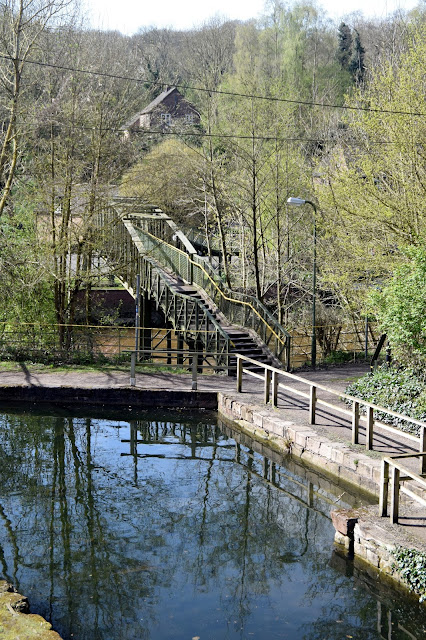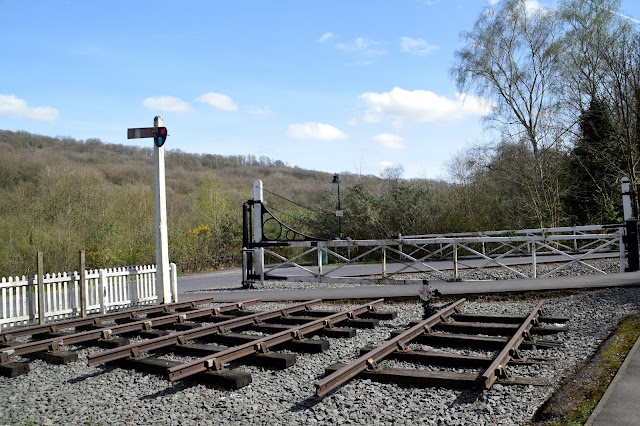"In valleys of springs or rivers, By Onny and Teme and clun, The country for easy livers, The quietest under the sun."
A Shropshire Lad - Housman.
The area we are about to explore is situated on the banks of the
mighty River Severn, where the houses and businesses cling to the sides
of the beautiful Severn Gorge.
It is a unique industrial and natural environment which was formed
during the Ice Age when the original flow of the river was diverted,
escaped and formed the now famous Gorge.
My journey starting at Madeley which take me along roads which run
parallel with the river and diversions to places with the names of Coalport, Jackfield and ending in Ironbridge. Areas which
all made their mark in our industrial heritage.
 |
Blists Hill Victorian Town
One
of the gorge's most popular attractions and operated by the Ironbridge
Museum Trust, the museum is a massive open-air complex re-creating life
in a small industrial town during the 19th century.
All the staff are dressed in period costume and are many specially-trained to demonstrate the crafts and trades of the times. |
In Victorian times all of these areas had foundries, kilns and fires
making the area a buzzing, smoke-filled port which was dark and dusky
Today see how the area has changed! The grime and the dark smoke is long
gone. Now there is wildlife and wildflowers in abundance on the
numerous walks around the gorge. Nature has reclaimed the quarries and
turned them back into green woodlands with clear brooks running through
them.
 |
On the Coalport side of the bridge is the Tar Tunnel, operated by the Ironbridge Gorge Museum Trust.
The tar tunnel is an unusual source of natural bitumen. Discovered
over 200 years ago, you can still see the black tar oozing from the
walls. |
 |
| Coalport was really the vision of an iron master called William Reynolds
in the late 1700's who saw the area as a hub for the iron industry and
built warehouses, factories and accommodations for his workers |

 |
The former Coalport china works has now been converted into an
exhibition area to display the National Collections of Caughley and
Coalport china.
China was made on the site from 1796 until 1926 when it moved to the
bigger china manufacturing county of Staffordshire. However the museum
represents all the initial efforts. Daily demonstrations of china-making
can be seen in the workshops and visitors can purchase fine examples of
all their work in the museum shop. |

 |
Maws Craft Centre
In
the 19th century the Maws factory was considered to be the biggest
manufacturers of tiles in the world and were used in decorative aspects
of the home such as floors, fireplaces, wall trim and bathrooms.
Industrial usage included butchers, kitchens & hospitals (because
they were so easy to keep hygienic). They were made into clocks,
coasters, trays and all sorts or ornaments. |

 |
Jackfield Tile Museum
The
Tile Museum was home to the Craven Dunnill factory, where decorative
tiles were mass-produced from 1874 until just after the Second World
War, Jackfield Tile Museum is the best surviving example of a
purpose-built Victorian tile factory |
 |
Bedlam Furnaces
The
Bedlam Furnaces were one of the earliest furnaces to use coke instead
of coal to smelt iron. They were blast furnaces which meant there was a
blast of air generated from water powered bellows.
There were 2 furnaces and engine room and the bellows. Coalbrookdale
purchased these furnaces in 1776 (date of the American Independence!).
There was also a brickyard above this furnace area for a time. The site
was made an ancient monument in 1973. |
 |
| The main shops, food/drink establishments are all located along the one
side of the street and the square so you will not miss anything that is
on offer. There is a wide selection of gift and specialty shops, plus
cafes, pubs, restaurants, wine bar, antiques, tobacconist, charity
shops, bakery, speciality pork pie shop and Cornish pasties, hair
dressers, post office, pharmacy, estate agents and more. |
 |
Ironbridge (Buildwas) Power Station
Continuing along Buildwas Road towards Ironbridge you will see the
buildings and four cooling towers of Ironbridge Power Station
established 1965. |
 |
The bridge opened on New Year's Day 1781 and was the result of work by the architect Thomas Pritchard and Abraham Darby III.
Unfortunately Thomas Pritchard did not live to see it in completion.
Abraham Darby received a gold medal from the Royal Society of Arts for
his endeavours.
The bridge has long since ceased to be able to support vehicle traffic but you can walk across and view the river and the town. |













































No comments:
Post a Comment